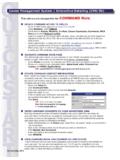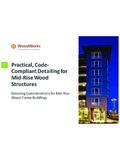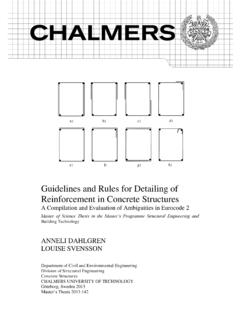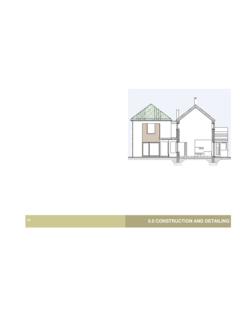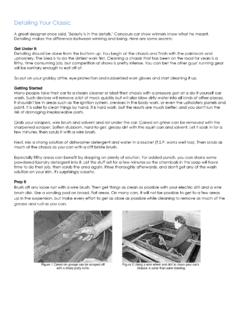Transcription of Practical Prestress Detailing for PTIA
1 Practical Prestress Detailing Disclaimer: "This presentation is for guidance only & is not to be taken as specific advice applicable to a particular project.". This presentation will only cover bonded post-tensioning, because Structural Systems do not claim to be knowledgeable about pre-tensioning nor about unbonded systems (as used in Europe & North America). Topics: 1. Selection of slab system or multistrand, strand size & grade, number of strands /. tendon. 2. Cover & selection of tendon drapes. 3. Concrete thicknesses for pans, anchorages & couplers. 4. Anti-burst reinforcement & transfer strength.
2 5. Co-ordination with reinforcement. 6. Miscellaneous. 7. Tendons at joints. -----0----- page 1 of 21 pages 1. Selection of: slab system or multistrand, strand size & grade, number of strands / tendon. Multi-strand' = all strands in a tendon generally stressed simultaneously; round duct & square anchorages. Slab system' or Mono-strand' = strands stressed individually, flat / oval duct & rectangular anchorages. (refer Structural Systems Prestressing Technology brochure). We use "slab post-tensioning" in preference to "mono-strand", but they mean the same thing. Slab post-tensioning systems are very similar amongst all the companies in the post-tensioning industry.
3 "Multi-strand" is usually only necessary for bridges, silos, tanks, off-shore structures & larger transfer beams in tall buildings. We often find projects where multi-strand is specified, but slab system is more suitable, because: generally a greater drape & lever arm can be achieved; &/or jacks are smaller, likely to avoid the need for stressing recesses or blockouts; &/or jacks are hand weight, not requiring cranage; &/or stage stressing can be achieved by fully stressing selected tendons instead of partially stressing all tendons; &/or smaller individual live & dead anchorages; &/or simpler anti-burst reo.
4 Whilst still achieving the required stressing force & lever arms (for flexure). How many strands can be fitted into a band beam without using multistrand ? Methods of fitting in more force as slab system: use or tendons stacking live & dead ends, divert tendons in plan to reach low & high points: centrelines of live ends 300 mm cl to cl horizontal centrelines of live ends 100 mm cl to cl vertical spacing of (70 mm) duct 150 mm cl to cl in plan, 100 mm cl to cl vertically spacing of (90 mm) duct 175 mm cl to cl in plan, 125 mm cl to cl vertically locate ~half of the live ends at each end (for single live tendons).
5 Refer examples, Figures. 1, 2 & 3. Use double live ends only where necessary. Maximum tendon lengths (limited by force losses): band beam tendons about 30 m single live, slab tendons about 40 m single live, distribution & slab on grade tendons about 50 - 55 m single live. Double live can generally go twice the above, but pour sizes usually control. Minimum tendon lengths usually about 6 m (otherwise draw-in losses excessive). Underside stressing is where the live end is accessed from below concrete. Only applicable to slab system, because multistrand jacks require suspension. To be avoided, as it requires formwork to be built to allow access without stripping.
6 Initial stressing is usually impractical for underside stressed tendons. Underside live end anchorages must be min. 80 mm clear below soffit behind live end, & be stripped before 1st stressing to allow sufficient access. Underside stressing on either or both ends of a double live cable is NOT acceptable. This is for safety, as with double live no part of strand is bonded into concrete, & stressors are more likely to be closer to strand. Where possible, always use pans instead of undersides. Distribution tendons in 1 way structures: multiple 2 or 3 strand tendons can often be replaced with one 5.
7 Strand. Minimise number of tendons by maximising spacing (usually 10xD), consistent with the maximum number of strands per slab system tendon. page 2 of 21 pages (Maximum tendon spacings were stated in AS1480. No specific limits stated in AS3600, it is a matter for design.). Sizes & grades of strand available: super super EHT: not always available, &. likely at a cost premium, &. cost premium is usually more than the extra strand force. Generally strand is the same cost / Tonne as BS5896 / Euronorm / mm / mm strand not usually available in Australia (included in Structural Systems Prestressing Technology brochure for use in UK).
8 Use only 1 strand diameter & only 1 strand grade in a project, because: market pricing will be more competitive;. multiple strand sizes provide another potential avenue for error on design & shop drawings;. multiple strand sizes can congest site with more coils & provide another avenue for error. strand is by far the most commonly used, especially in NSW. We find is the better choice for most structures, allows designer to more economically select tendon size to match design requirements. For a heavily loaded structure or heavily stressed structure where strand will reduce the total number of tendons, is usually the best choice.
9 Page 3 of 21 pages 2. Cover & selection of tendon drapes. Cover to tendons: often cover to perpendicular reinforcement ( top bars, beam ligs or distribution bars) will govern obviously governed by AS3600 requirements for durability & FRL. for strand in slab system tendons at high & low points, it is usual to take 5 mm of this cover being the duct & grout (ducts are galvanised are beneficial to corrosion protection). similar is considered reasonable for strand minimum 25 mm chairs at low points (to avoid concrete popping off during grouting). minimum 20 mm cover to duct at high points (for same reason).
10 Drapes generally Chair & anchor heights to be co-ordinated with all reinforcement, including distribution bars. Refer Figure 4. Live ends in edge beams to be co-ordinated by the designer with reo, such that void former (refer SSL. brochure) fits under the corner bar, taking into account concrete cover, links, slab reo layering, corner bar diameter, tolerances & real bar sizes. If distribution or other bars clash with tendons, re-layer or label them to be installed after post-tensioning. Drapes specific to one-way (banded & transfer) structures Refer Figure 5. Slab tendons to drape to edge of beams, only exception is sometimes for edge beams.




